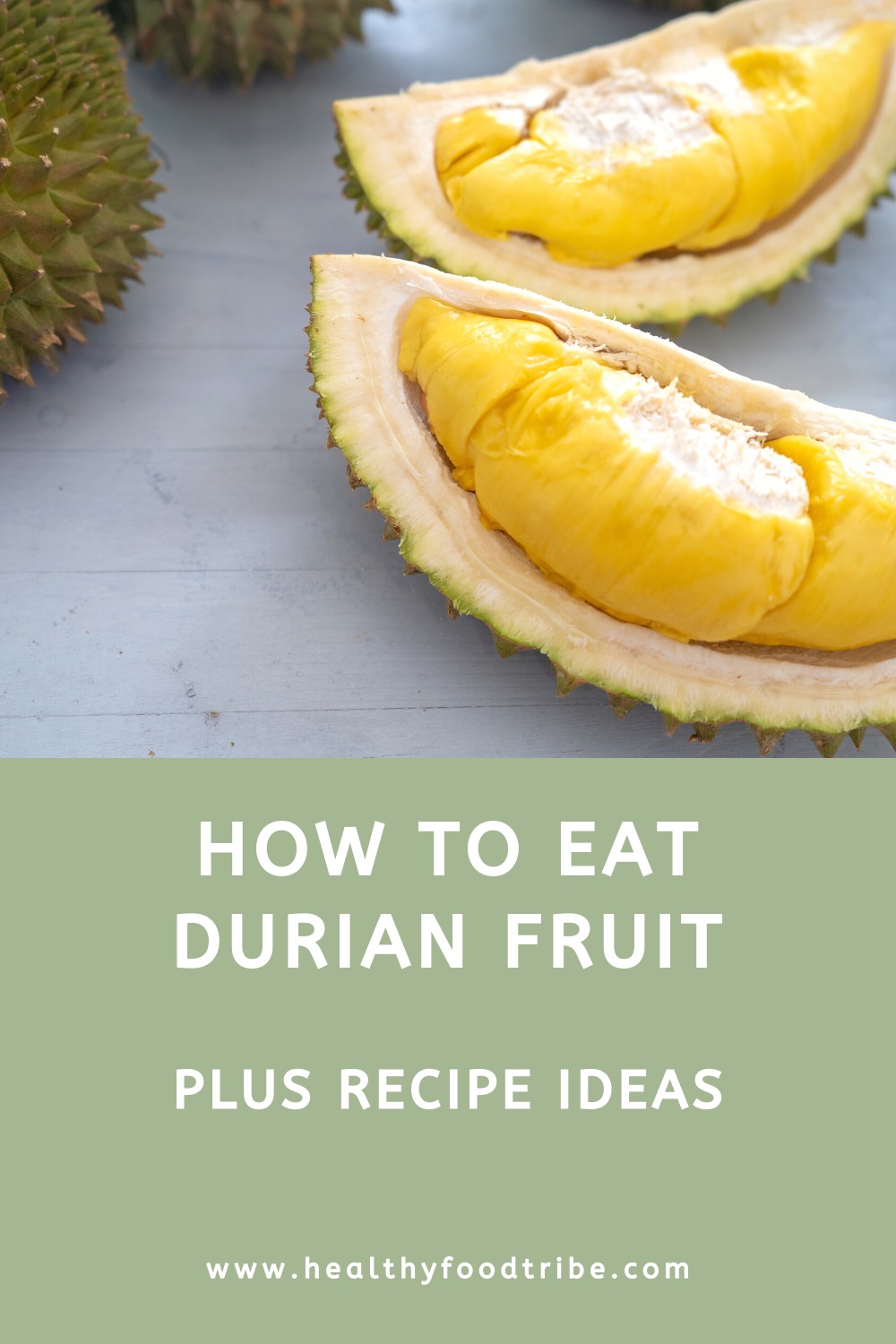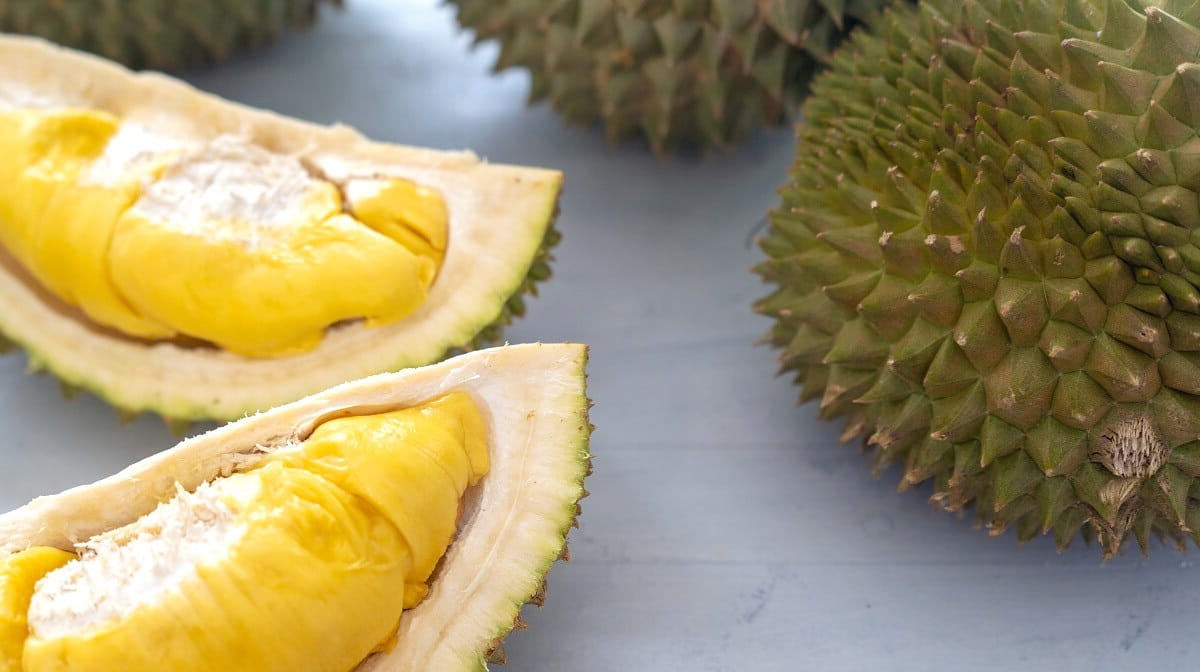Last updated: August 19, 2023
What is the durian fruit, and how should we cut, prepare, and eat it? This guide explains everything we need to know about eating this unique fruit.
Fruits are rarely the source of contentious debate, but the durian has caused numerous heated arguments in its time. While this strange fruit is loved by millions, it is also outlawed on most forms of public transportation in Asia.
So, is the durian the most delicious fruit known to mankind? Or is it a stinky abomination that should never be cultivated again? There’s only one way to find out, and that’s to try one for yourself!
But to do that, you’ll need to know how to eat durian. Given the unique look and structure of this fruit, neither is very obvious. In this article, I will tell you everything you need to know about durian, including the easiest way to cut and eat it.
What Is the Durian Fruit
Before I explain how to cut, prepare, and eat a durian fruit, let’s first take a look at what it is, where it originates from, and what it tastes like.
The durian fruit frequently grows to 7 pounds and can be as large as 8 inches in diameter. The hard rind is covered in numerous pokey protrusions. This rind is similar to that of jackfruit but far spikier, with each protrusion coming to a sharp point at the end.
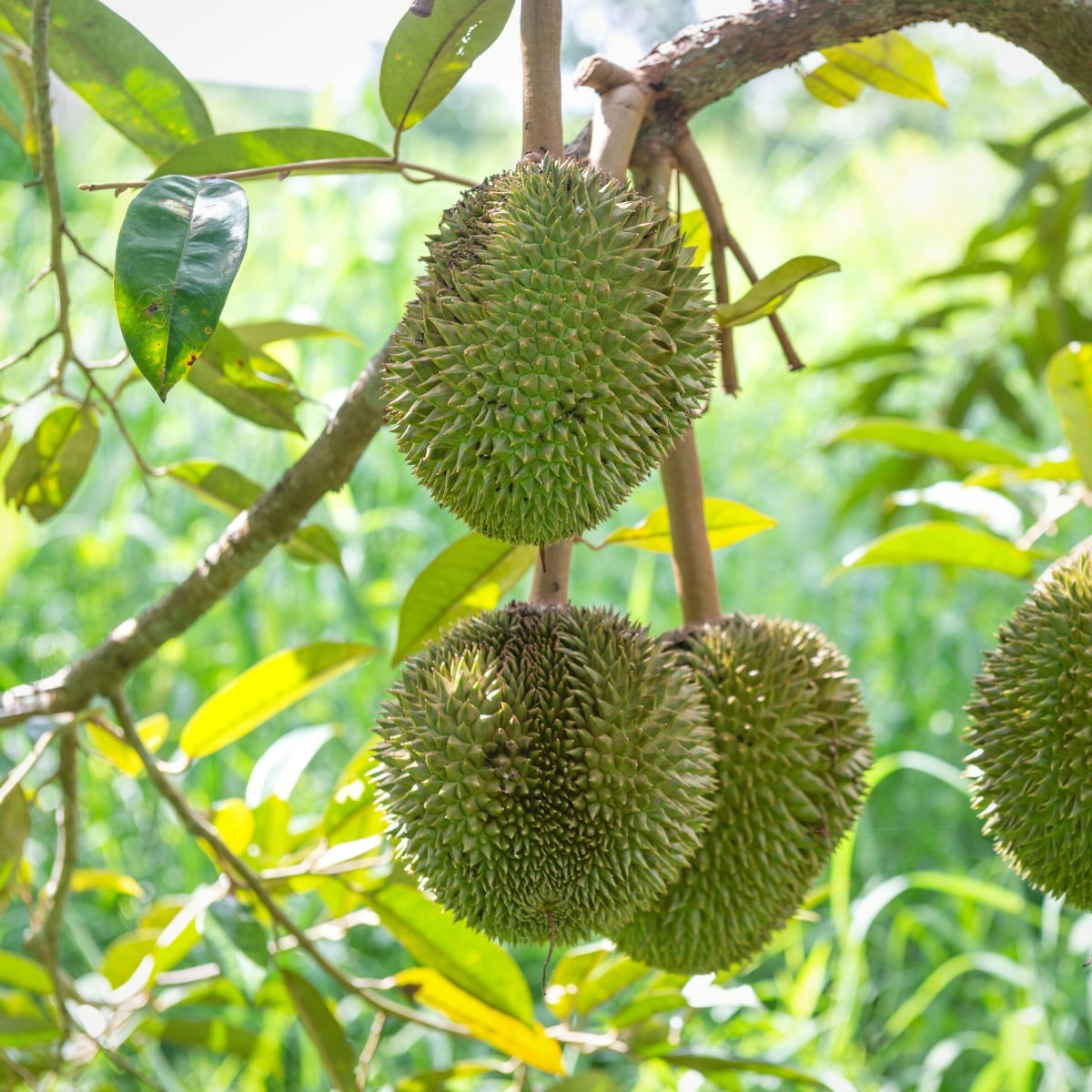
Durians start out green and mature to tannish-yellow as they grow. There are at least nine species of durio tree that produce edible fruits, but only the Durio zibethinus is cultivated for global distribution.
Origins of Durian
The durian is native to Southeast Asia (Borneo and Sumatra), with the name “durian” derived from the Malay-Indonesian language word for duri or “spike”, a reference to the numerous prickly thorns of the fruit’s husk.
The fruit is widely grown in various countries around this region, including Malaysia, Indonesia, Thailand, and the Philippines. It is also grown in Hawaii and other tropical locations around the world.
Types of Durian
There are about 30 recognized durian species, but only a handful are suitable for consumption.
Here are some of the most well-known ones:
- Durio zibethinus:
This is the most commonly known and eaten species of durian. Varieties like the “Musang King” (Malaysia) and “Monthong” (Thailand) belong to this species. They are known for their creamy, sweet-to-bittersweet flesh. - Durio graveolens:
Also known as red-fleshed durian, it’s less common than Durio zibethinus and is native to the Indonesian and Malaysian rainforests. The flesh is deep red and has a flavor often described as wine-like. - Durio kutejensis:
Often referred to as the “Pulu” or “Kutej” durian, this species is native to Borneo. The fruit is smaller than Durio zibethinus, and the flesh is sweet and somewhat nutty in flavor. - Durio oxleyanus:
Known as “Keris” in Malaysia or “Sukang” in Brunei and the Philippines, this durian species has a strong, pungent smell and a bitter taste. - Durio dulcis:
Known as “Durian Merah” or red durian, this species is native to Borneo. It is rare and treasured for its sweet and creamy red-colored flesh.
Note that the taste and texture of durian can vary widely even within a species, based on factors such as variety, ripeness, and growing conditions.
Flesh and Seeds
Durians don’t just look unique, the inside is also very different from any other tropical fruit.
Beneath the hard outer rind of the durian are multiple separate compartments called carpels. Inside these carpels are fleshy, dough-like arils surrounding large pits. The arils are shaped like large beans, and it is the flesh of the arils that is eaten.
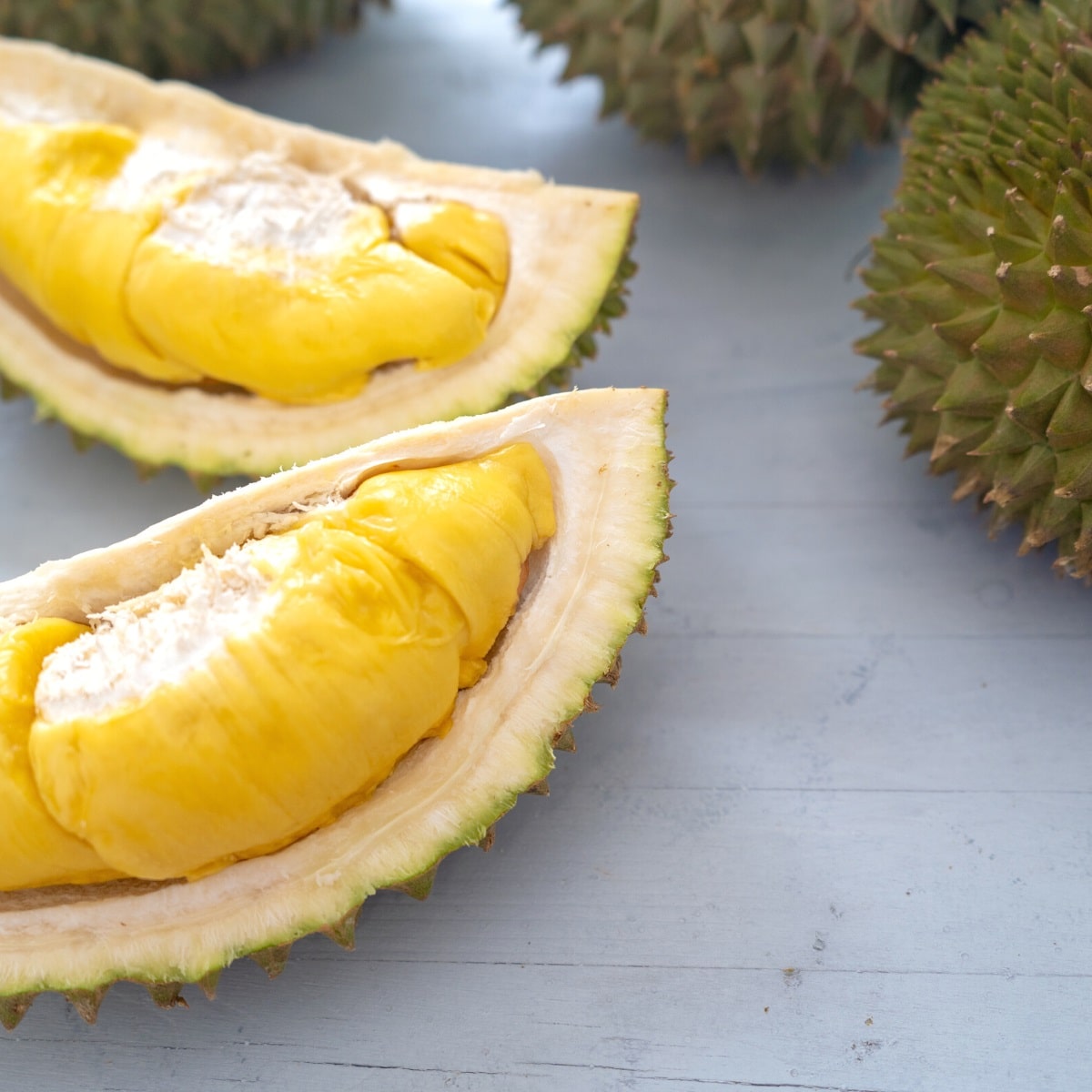
While the seeds are inedible when raw, they can be cooked and used as natural food stabilizers or starch alternatives. The rind is inedible and should be discarded.
Ripe durian flesh has a unique texture. It is dense but smooth, and soft like egg custard. It can be creamy white, yellow, or red in color.
Taste and Smell
The flavor of durian can vary somewhat by variety, but all possess a certain light sweetness combined with an intensely pleasing creamy texture. Notes of caramel and vanilla are also common.
But backing that sweet flavor is usually a pungent, musky, stinky-cheese taste. It is this second flavor that is most notable in the odor put off by durian. The smell of these fruits is so pervasive and offensive that they have been outlawed from subways and public buses in Asia.
Many colorful words have been used to describe the smell of durian throughout history. It’s been likened to stale vomit, pig excrement, onions, old gym socks, and “a bunch of dead cats”.
The odor is certainly distinctive, but what is even more unique about this fruit is that most people who are brave enough to try it love it so much that they start to enjoy the smell. Indeed, Bangkok-based food writer Bob Halliday, who described the smell as dead-cat-like, says he now drools “like a mastiff” when he detects the offensive odor of durian in the air.
Nutrition
As if this fruit didn’t have enough setting it apart from its kind, it is also distinctly nutritious. In the fruit category, which includes many foods noted for their nutrient content, this fruit truly is king.

Durian is loaded with vitamin C and fiber. It is also one of the few fruits to contain a long list of B vitamins, including niacin, thiamine, riboflavin, folate, and vitamin B6 (source).
It also has plenty of minerals, including magnesium, copper, and potassium. Compared to other fruits, it also has a uniquely high amount of fat, but this is mostly monounsaturated fat.
Read my guide to yellow-colored fruits for more unique fruits with a beautiful yellow color.
Cutting and Eating Durian
Intrigued by what lies at the center of this foul-smelling, spikey fruit? Before you can find out, you need to cut it open.
While this may seem like a tall order, given the protective, hedgehog-like shell it has, it’s actually quite easy if you know how to approach it.

Before you start, it’s best to choose an outdoor area or well-ventilated area indoors to cut the fruit because of its strong smell that many find unpleasant.
Lay down newspapers or plastic bags for easy cleanup afterward. You’ll also want to have a large bowl handy to hold the fruit’s flesh. Protect your hands by wearing thick gardening gloves, or wrap your hands in thick cloth.
Steps to cut and eat durian:
- Start by laying the durian fruit on its side on a cutting board.
- Locate a seam, one of the indentations that run from the stem to the blossom end.
- Cut the rind along the seam about a quarter inch deep, making sure to cut past the blossom end notch.
- Use your fingers to pry open the shell, exposing the creamy arils inside the carpel.
- Use a large spoon to scoop out the arils and set them aside.
- Looking at the blossom end of the rind, locate the next seam.
- Cut it the same way you did before, then pry open that carpel with your hands.
- Repeat this process until you have opened all the carpels and pulled out all of the arils.
- Use your fingers to locate the seed pit in each aril.
- Push your thumb in to expose the seed and remove it from the flesh.
Now you have clean, seedless durian flesh to work with. You can eat it raw or use it in various sweet and savory recipes.
Practical Tips
Now that you know how to access the delicious flesh inside a durian, here are a few tips for working with and putting this incredibly unique fruit to use.
When is a Durian Ripe
The smell is a good indicator of a ripe durian. Those that are perfect for eating have a pungent musty, cheesy odor, but not one that is overpowering.
Another good trick is to raise the durian to your ear and give it a shake. If you can hear the arils rattling around inside, it’s ripe.
Next, check the seams on the blossom end. The seams should be apparent but not already splitting. If they are, the fruit is likely overripe.
Where to Find Durian
Durians are widely available at markets and fruit stands throughout Southeast Asia. They are in season from June through September, with a minor harvest in December.
Because of their pungent odor and other shipping concerns, durian is rarely exported. That means if you live on the US mainland, you’ll have to travel to taste one of these strange fruits for yourself. Luckily, you don’t have to go all the way to Asia.
Durian is available seasonally in Hawaii and Puerto Rico. You can also find it at many local markets in Mexico, Central America, and South America, though the fruits tend to be priced high in these regions.
How to Store Durian
Whole durian should be stored somewhere dry, cool, and dark. Not-yet-ripe fruits should be placed in the cupboard or pantry. They typically last a few weeks when stored this way. Ripe fruits can go in the fridge until ready to eat.
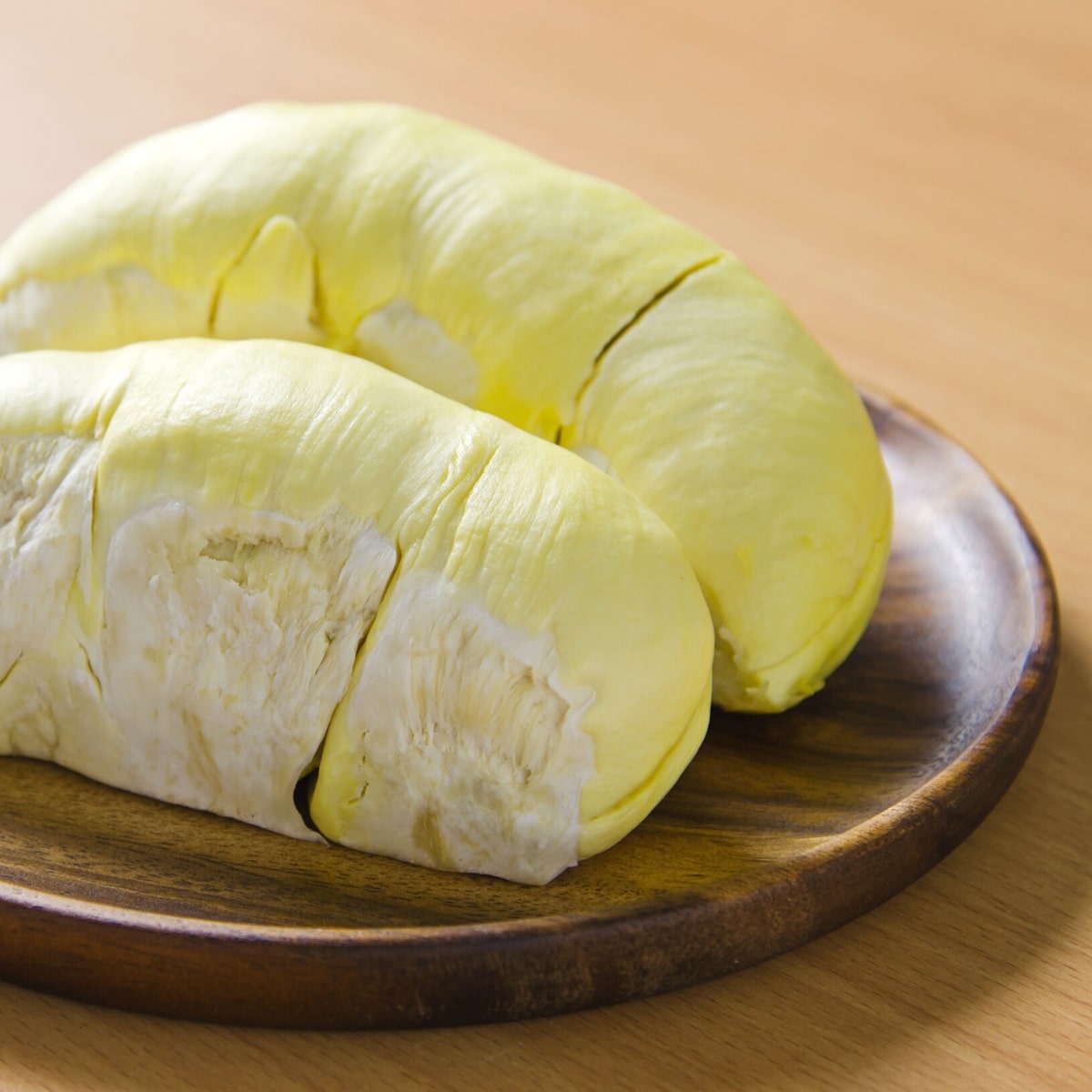
Durian flesh should be stored in an airtight container in the refrigerator. Be mindful that the flesh bruises easily, so don’t stack it in the container and handle it gently.
The flesh also freezes fairly well. Be sure to remove the pits, then place the flesh in an airtight container and freeze for up to six months.
Durian Uses and Recipe Ideas
The complex flavor of durian is often enjoyed fresh without any additions. But it can also be included in smoothies and juices, or as a topping for oatmeal, yogurt, and ice cream. In Asia, it is often used to create flavorful sticky rice desserts.
Baking with durian is also popular. Durian souffle, cheesecake, donuts, and crepe-style apam are all amazing options. But you can use the unique flavor and texture of durian to elevate most desserts.
Ripe durian is often mashed and included as a filling for puff pastries or fried into fritters.
Unripe durian fruit is used in many savory dishes, as well. It can be sliced and added to curry, cottage pie, and egg tarts. The flesh can be grated and fried to create edible baskets for fruit salads or edible plates and decorations for cakes.
